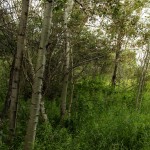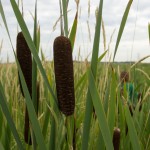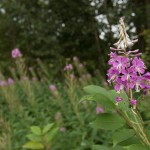You won’t find the Pits marked on any map, and many people who live nearby simply refer to the area as ‘the farmers’ field’, ‘the forest’ or by no name at all. But to the children who grew up in southeast Mill Woods during the 1980s and ‘90s, the Pits were a ‘wild west… frontier land’ and a ‘magical nature area’ that ‘opened up our spirit of exploration’.
Often, the experiences of children are overlooked when examining heritage. But,without these stories, the history of Mill Woods is incomplete. Mill Woods is a budding community that attracted many young families throughout the end of the twentieth century, making Mill Woods’ past inextricably intertwined with the childhood experience.
For twenty years, the Pits existed as a kind of ‘no- place’, unplanned, unnamed and unsupervised. But this very status, this very existence as a non-place allowed it to serve as a blank canvas for the imagination of childhood. The undeveloped region south of Mill Woods wasn’t just the end of the city, but of the everyday life of school, parents, and daily chores. The Pits was where the mundane faced off against the infinite unknown.
The Pits was, or some would argue still is, a natural area ‘that, for the longest time, was just a wilderness, wooded area.’ The area is quite diverse featuring ‘wetlands, grasslands… agriculture, patches of aspen, lots of native grasses’, seasonal ponds and ‘even a sandy area in one spot.’ To the north, the final row of housing in the Sakaw neighbourhood and to the south, what was once a seemingly endless wheat field that awakened in young people a ‘natural draw to go… and explore’ is now divided by Anthony Henday Drive. While the Pits still retain many of these same natural features, development of the area has altered a fundamental characteristic of the middle years of settlement this place: the endless space at the edge of the city.
The origin of “the Pits” as a name might be found amid the geography. There is a large marshy area, and a number of sandy places, which could easily be considered the eponymous pits. The walking trail that is still used by dog-walkers, cross-country skiers, and child explorers, appears to have existed continuously since 1978, if not earlier, and seems to be the dividing line between cultivated fields and marshland.
Regardless of the origin of the term, “the Pits” has been used as a name at least since 1985, and it continues to be used as evidenced by a spray painted Transportation Utility Corridor sign. When asked where they first heard the name, interview participants were themselves unable to pinpoint an origin story.
‘I couldn’t tell you when I first heard that name… but as far back as I can remember it was the Pits.’- Matthew Long
‘It was always called the Pits, I don’t know where the name came from… I guess we just naturally called the area the Pits because there was a pit of sand.’ – Barrett Forbes
‘I never understood what the Pits meant. As I got older, I thought… it had to do with how the landscape is so hilly… little crevasses, ravines, pockets that would turn into ponds sometimes… maybe that’s why it’s called the Pits. But I never really knew why it was called that; I can’t remember who introduced me to it.’ – Curtis Faryna
Equally mysterious was what actually happened out there on the edge of town. Curtis Faryna remembers ‘a scary place… a lot of myths and rumors about what went down there. For many years, [my friend and I] would… stay at the entrance and peek in… it was just so uncertain to go over that fence and explore that unknown area.’
A lack of adult supervision might be partially responsible for the Pits scary, mysterious quality. Barrett Forbes recalls that the Pits weren’t so much a ‘No Parents Allowed’ place but more so a ‘Kids Only’ zone. Not so many little kids but… the youth of Mill Woods would escape back there… no adults whatsoever.’ Similarly, when Matthew Long looks back on the Pits as an adult he thinks about ‘how it was like a wild frontier land. We would go out there and our parents were nowhere to be seen… but it wasn’t so much like a wild land when I was a kid, it just was some place to go and to discover and explore.’
Here, unsupervised and without the weight of parents and teachers tethering them to reality, imaginations ran wild. Some kids created mini societies within the trees:
‘I had some friends that I met… who were part of some sort of kid tribe… One day, they blindfolded me and led me to [their] secret area. Along the way they were telling me where to stop and to be really careful because they had set up booby traps everywhere in the forest. I remember them telling me that one of the booby traps was a big log that was hung up in the trees and that if I stepped over this wire it would be triggered and would come swinging to crush and kill me.’ – Curtis Faryna
Others experienced their first taste of danger:
‘[My friends and I] wandering aimlessly around the Pits… and came to one of those lumber bridges across the creek that we had taken to get into the Pits. As we were crossing that creek some other kids came up and we … were confronted by them… and they had guns.
The next day my buddy told me that those were just BB guns… I remember feeling… put in my place that day by these kids … when I look back on my experiences at the Pits, I look at it through the lens of that event.’ – Matthew Long
To many, the Pits represented not only a setting for one story or another, but became nearly synonymous with their childhood.
‘It was all significant, it was all my childhood… And even though it was the same thing everyday, it never got old and it never got boring… Honestly, it was all significant, if that makes sense.’– James Musat
As the geography in and around Edmonton shifts, so to does our heritage. And while the shared experiences and stories of the Pits may never find a place within the pages of any history book, they are still an integral part of Edmonton’s history. It’s critical that we look for beauty and meaning in the mundane and hidden because it is these everyday’ experiences that shape our communities. So let us remember the lessons learned, the experiences gained, and the endless opportunity that this space provided. Long live the Pits!




